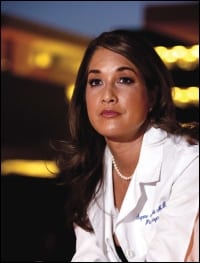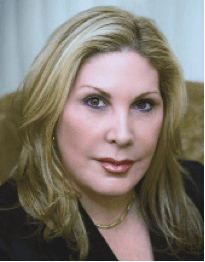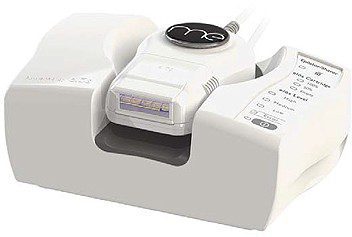
Suzanne M. Quardt, MD, wanted to be a physician since childhood. “When most people are asked when did they know they wanted to be a physician, they usually say, for as long as I can remember,” she says. “But I have proof. My mom saved a little autobiography I wrote in the third grade called ‘Suzanne Quardt, Future Doctor.’ In it, I was ‘Dr Quardt,’ and I even drew a little stethoscope, syringe, and a black doctor’s bag on the cover. Growing up, I enjoyed dance, the arts, music, and classical piano. However, I always felt I wanted to help people, so medicine and being a doctor just seemed the perfect fit.”
As the recently appointed chief of plastic surgery at Eisenhower Memorial Medical Center in Rancho Mirage, Calif, near Palm Springs, Quardt has achieved several ambitions for someone barely out of her third decade. She is a member of the American Board of Plastic Surgery, and a diplomate at both the American Society of Plastic Surgeons (ASPS) and the California Society of Plastic Surgery (CSPS). In addition, she runs a private practice, also in Rancho Mirage, called Palm Desert Plastic Surgery. Her motto? “A surgeon’s hand with a woman’s touch.”
When the position of chief of plastic surgery came up at Eisenhower, “There were other older, more established male plastic surgeons vying for the job,” she says. “The position wasn’t even on my radar. However, I received several calls— one from our department’s chief of surgery, who asked me personally to consider the position. I was both shocked and extremely honored. After discussing it with my husband, staff, colleagues, and friends, there was no other answer but, ‘Absolutely!’ ”
At once, she was thrust into the world of big hospital politics in a small community. “I had to learn diplomacy very quickly,” she notes. “It’s a skill set that is very valuable. We, as physicians, need to band together and respect one another. I am not a confrontational person, and I experienced new challenges regarding peers [who] were both close and not so close. Overall, I have learned to remain open, objective, and fair in order to better serve the hospital and the best interest of our patients and community.”
What guides her decisions, and what keeps her going through all the challenges? “I do things by very simple tenets,” she says. “I mean the very first thing—it sounds hokey, but it’s true—is our Hippocratic Oath verse: ‘Do no harm.’ “
The second is something that she often heard from Randolph Sherman, MD, chief of the Division of Plastic and Reconstructive Surgery at the University of Southern California. “And I always say it, too, because it’s also very Spike Lee. He would always just say, ‘Do the right thing.’ That’s the bottom line. Whatever you’re doing, just do the right thing. I go by that. I go by my gut and what I feel is right and in the best interest of our patients, do the right thing. I bring it up because I always have that in the back of my mind.”
INSPIRED TO DO NO HARM
“I was a foster kid until around the age of 3,” Quardt begins. “My parents adopted me. My parents were really my biggest inspiration. My mom would say, and I remember her words, ‘I want you to be a doctor.’ Then she would even say, ‘I don’t want you to be a nurse, I want you to be a doctor.’ Later, when I was talking with her about it and her encouragement of me, she said it stemmed from when she was being raised. Women didn’t really have positions of authority and power. Her mother wanted her to be a nun, and she did not want to do that. The next best job for a woman, I guess, other than nursing, was teaching. So, she became a teacher. I guess she just had high hopes for me and wanted me to be a doctor and achieve. She gave me a lot of confidence because she always stated it just very plainly and instilled it in my head so early.”
Whereas Quardt’s father, also a former teacher and accomplished computer scientist, would have been more passive and simply let her become whatever she wanted, her mother pushed her. “She was very strict growing up, and everything was study,” she says. “I think it’s lucky for me that I enjoyed science and biology and physiology and pre-med, because if I didn’t like that stuff it would have been an issue. I’m grateful for that, too. When I look back on my studies and the stuff that I really enjoyed—because some people really enjoy a broad spectrum of studies—I always migrated toward biology and dissection, anatomy and all that.”
Though she knew she would become a physician, she didn’t start out with plastic surgery in mind. “I wanted to be a heart surgeon,” she explains. “Cardiac surgeons were just my idols. When I was growing up, cardiac and lung transplantation were really big. I did a sub-internship in New York City, Columbia, when I was in medical school. That’s when I met Mehmet Oz, MD, Dr Oz, who’s now famous.”
Oz inspired Quardt to decide to become a cardiac surgeon. After 2 years of general surgery training, she went into a cardiothoracic research fellowship for 2 more years. “I loved it,” she says. “heart transplants on rats and microsurgery. I was performing cardiac surgery on pigs, studying reperfusion injury and testing novel devices. Plastic surgery rotation was only one month of the intern year. I did plastic surgery, and I thought it was interesting. I didn’t know they did microsurgery. I didn’t know what a flap was, and I thought, ‘Oh, this is really neat.’
“Then they made plastics a second-year resident rotation. Then they made it a third-year resident rotation and I did it again. By then, I was quite seasoned. I like the plastic surgeons because they seemed very well-rounded, meaning they loved their work but they also loved their families and their life outside of the hospital. They were passionate about what they did, were technically excellent and seemed to have it all. They were also genuinely supportive and outstanding mentors. This was most appealing to me.”

Quardt’s Rancho Mirage, Calif-based private practice focuses on breast-related cosmetic surgery.
Quardt concluded that cardiac surgery was not for her after all. “I admired how dedicated they were,” she says. “But then, when I was more intimately involved, I saw things that were not so desirable, meaning that for every advantage there’s a disadvantage. Meaning, if you’re going to commit that much time into the hospital, something else suffered, and I saw it was their family lives.”
Quardt’s moral principles and priorities also nudged her in the direction of being a plastic surgeon. “I had one professor who was getting divorced, had multiple marriages. He said, ‘My daughter hates me.’ That was so sad to hear. He was a wonderful man, a great teacher. It makes you start to think as you reach that time in your life when you’re thinking about family and where do you ultimately want to be. It was an ‘A-ha,’ moment,” she says.
THE GUMMY BEARS
Her first experience working in a practice was with Grant Stevens, MD, FACS. “He was really busy,” she says, adding Stevens’ practice “was a well-oiled machine. His expectations were really high, and people met them. People jumped and worked hard.”
What Quardt really liked was breast surgery. “I liked the female patients,” she says. “Breast surgery may sound simple … because most people just think of breast augmentation. But in breast surgery, there is augmentation, reduction, mastectomies, and reconstruction. Then there’s the whole aspect of revisional surgery—that is a complicated case. And then ptosis of breasts, and combining procedures and all that.”
At the time, Stevens was involved in the Gummy bear trials,” she notes, referring to cohesive breast implants, also known as the silicone gummy bear breast implant or the cohesive gel implant. The experience “was good for me in terms of the exposure to the latest in breast implants. He was using something that was not even yet FDA approved, but it soon would be, so he was on the cutting edge of that. I got experience even to see what outcomes were like with those implants.
“During my time there, he heavily stressed research. What I concentrated on was looking at safety and efficacy of combining breast implantation with mastopexy, and I didn’t even realize at the time how controversial that procedure was among our peers in the plastic surgery community. Some people didn’t even do the procedure, flat out. They staged it. They said, ‘You do one and then the other,’ and then it varied on the surgeon as to which one they did first; the augment and then the lift, or the lift and then the augment. Grant Stevens had a lot of success doing it together, and yet people talked about it saying, ‘Yes, you could do it together, no it’s too risky, you’re going to have necrosis of the nipple and disastrous complications.’ He was able to show with data that it could be done safely and effectively in a combined procedure, so long as you follow certain parameters. That was great experience.”

In order for the profession to progress, plastic surgeons have to be progressive thinkers, Quardt says.
Understanding both plastic surgery techniques and also how a forward-thinking practice operates, Quardt believes that in order for the profession to progress, plastic surgeons have to be progressive thinkers. “We have to not just accept old ways of doing things but always think how can we improve,” she says. “How can we improve upon the way we’re doing it? That is, largely improving on your results. What’s interesting is now in this age of emerging technology, all these new technologies are coming into play, so you have new tools to work with to improve results. But then, you fall into this, wondering, ‘Hey, does this really work?’ No jumping on a bandwagon because it’s heavily marketed. You want to know that you’re truly getting better results.”
GREETING THE REAL WORLD
After 14 years of medical school, residency, and two fellowships, the real challenges began. “I was like a lot of young plastic surgeons,” Quardt says. “We come out of training and we’ve been working basically 7 days a week for years. We’ve been doing surgeries or procedures almost every single day and we’re in that mode, and then you graduate and all of a sudden you have nothing to do—you have no surgeries, no patients, nobody knows who you are. Then the next step is you wind up getting privileges at every single hospital in the area. I mean, I was on staff all over in LA, but if no one’s referring to you because they don’t know who you are, you’re not going to get cases. I bring up this point because it’s a real transition point in your career and it’s a real humbling experience. You go from go, go, go, and do, do, do, and you’re excited to transition into your next phase, which a lot of us dream of as our private practice. All of a sudden, you have no patients and you’re just basically the small fish in the big sea floundering around.”
Ultimately, Quardt took a job at a group practice in Southern California. “It was headed by a board-certified plastic surgeon that basically employed lots of new, young, emerging plastic surgeons,” she says. “The salary was fabulous, I have to say. I worked for them part-time for a while, just to see what it was all about.”
What she found was, for example, the case of a young male surgeon employed by the practice who operated on a woman, and she was unhappy with the results. She wanted him to perform a revision, and he wanted to do the revision. However, because the young surgeon was not an owner of the practice, he had no control over the decision to perform the revision without charge. The owner said no to no charge. As a result, the patient sued the young surgeon.
“That really scared me off,” Quardt says. “It was the first clue to making me realize that when you don’t have the control by owning your own practice, you have to abide by the rules of the people who run it. And it’s not necessarily in your’s or the patient’s best interest. I turned that position down.”
Another offer from another plastic surgery practice came in, and she took it. “What I learned from that experience—and this is really important to where I am now—is that when a private practice is owned by physicians other than yourself, your own patient care standards and the way that you do things is limited. You really have no ownership in the practice and really no voice. You can voice your opinion, but whether or not that gets carried out or implemented, or equipment is purchased because you feel it’s necessary, or required, is not always the case. I was getting a real life lesson about the business aspect of private practice in plastic surgery.”
It was a “bit of a rocky road,” she says about learning about art of running a practice day-to-day. “We don’t get taught any of this stuff in medical school or in training, so you kind of learn it by the seat of your pants,” once you get out of school.
Another contrast between life in training versus life in the real world: making use of cutting-edge technologies is not always an option.
For example, during training it never entered her mind to not use the newest technology or technique. “You have everything available to you, so if you want to use the latest, greatest product off the shelf that cost a gazillion dollars, well, guess what? It’s there and you can use it,” she says. However, the latest device or technology may not be available to the physician in private practice.
BREAKING AWAY

Quardt was recently appointed Chief of Plastic Surgery at Eisenhower Medical Center in Rancho Mirage, Calif.
Quardt joined forces with a female board-certified plastic surgeon in Palm Desert, Calif. “She really was wonderful. She supported me. We had things in common. She was one of the first female board-certified plastic surgeons in the country. She and I shared the same kind of ethics in regards to patient care and how we dealt with patients. She just supported me on a human level, and let me build my practice in her office that we shared. I will be forever grateful for that.”
Later, she joined the staff at Eisenhower, acquired privileges, and went on to get board certification. “I realized that it was time for me to get my own office,” she says, and so she took that leap of faith and started a solo practice.
It has not been easy. “During these economic times, it truly is tough to start a private practice right out the gate,” she says. “I come from a great family, but not a wealthy one. When people hear that you’re a doctor and a plastic surgeon in particular, they automatically assume you have money. It’s funny to me. We are rich with knowledge, but not with capital.”
Quardt’s efforts to secure her own practice ran head-on into a tough economy. “The days of being able to get a business loan just like that”—she snaps her fingers—”were gone. The older surgeons could take 5 years to build up their practice and slowly pay back the money.” Not so when Quardt joined the ranks of plastic surgeons in private practice.
Today, she is reflective. “I look at colleagues who’ve worked their whole lives and thought they had a nest egg, only to lose it all. And now they continue to work really hard without retirement being a realistic option. With all the economic turmoil and instability of health care reform, physician reimbursements dropping, and overhead climbing, sustaining your practice becomes increasingly challenging.”
During her early days in private practice, the key was to continue to be hard-working, dedicated, and just do good work, she says. “I remember a conversation I had with one of my esteemed professors, Dr Gary Brody. He told me to just do good work and that others around will ultimately take notice.”
She also recalled past words that still resonated, such as Dr Sherman’s voice in the back of her mind reminding her to do the right thing.
Even when she became the assistant medical director of Eisenhower’s new, state-of-the-art Wound Care Center, Quardt remained committed to her own ethics and ideals as well as those expressed by Brody, Sherman, Stevens, et al.
“If you just do your very best, stay true, and take good care of your patients, that speaks for itself,” she notes. “With me, my reputation got around the hospital and is now getting around the community. I take care of a lot of hospital employees, including nurses, doctors, and their spouses. To me, that is the ultimate compliment. That means that they trust you with themselves or their family member.”
In her new role at Eisenhower, among other things Quardt was able to control the type of high-quality care for patients.
“I go to all surgery departmental meetings. I’m also on the Quality, Assurance and Improvement Committee where we review cases internally to identify ways in which to improve performance,” she says. “I’m really proud to be on that committee, because it just shows that we are continually trying to improve, not being complacent and just letting things run as they are, but always trying to excel regarding our patient care.”
TAKING THE LONGER ROAD
Though she has enjoyed success at an early age, Quardt is the first to note how she let her ethics be her guide in life. “I think it’s a longer road, but the one best traveled,” she says. “There are shortcuts to everything in life. I could have taken a shortcut monetarily. I could have been well-compensated for my services, but ultimately I would not be doing the job that I desired to do, taking care of the patients in the way that I wanted to take care of them, and be in the place that I am today.”
Sarah Russel is a contributing writer for PSP. She can be reached at [email protected].






